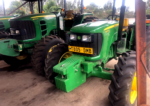Advertise Follow Us
Articles by John Dobberstein
Here are some of the best covers No-Till Farmer has published as the magazine celebrates its 50th anniversary.
Read More
Editorial Viewpoint
Impacts and Insights of Influential No-Tillers
Our editors hear amazing stories from no-tillers every day, but not every quote or anecdote makes it into print for one reason or another. Here, we chronicle a handful of tales from our encounters that have made a lasting impression.
Read More
No-Till Passport Series
Helping Zambia Reach its ‘Huge’ Farming Potential
A longtime Australian no-tiller and former speaker at the National No-Tillage Confernce is playing a major role in an organization determined to help Africa adopt modern farming methods.
Read More
Working Through Challenges with Cover Crops in Sticky Soils
Strip-tilled crops and cover crops are taking hold on Neil White’s Scotland farm, although wet weather, compaction and pest pressure still cause plenty of challenges.
Read More
6 Easy Hands-on Tricks to Assess Your No-Till Soils
Shovels, sieves, plastic cups and cotton garments are all that’s needed for a better understanding of your farm ground’s health, says soil microbiologist Kris Nichols.
Read More
How the Rhizophagy Cycle Could Boost No-Till Profits
Simply put, complex microbial processes in the soil do a more efficient, effective job providing nutrients to plants and can help no-tillers reduce inputs, says John Kempf.
Read More
FROM THE DESK OF JOHN DOBBERSTEIN











